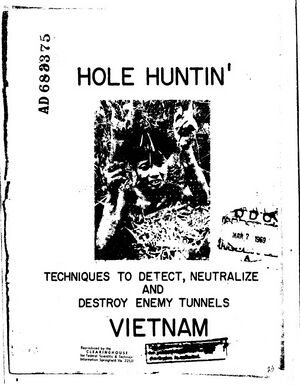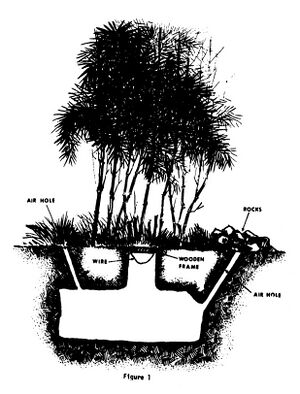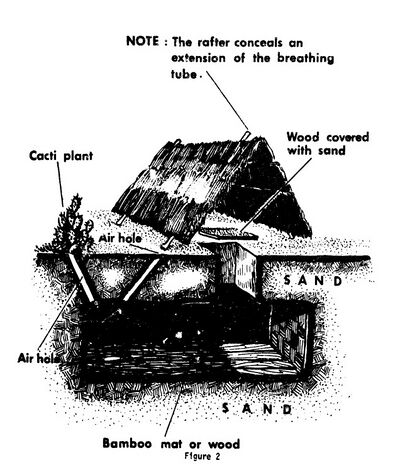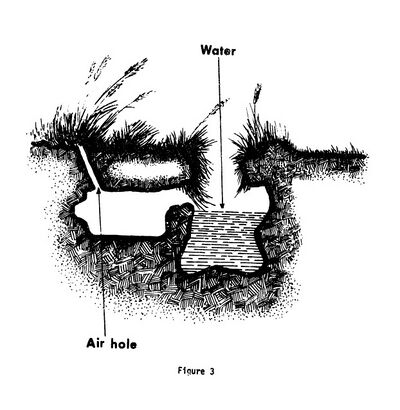| Author | Department of the Army |
|---|---|
| Subject | Counterinsurgency |
Publication date | 1969 |
| Publication place | United States of America |
| Text | Hole Huntin': Techniques to Detect, Neutralize and Destroy Enemy Tunnels online |
| AD686375 | |
Hole Huntin': Techniques to Detect, Neutralize and Destroy Enemy Tunnels was a brochure prepared by Major Ben G. Crosby and Lt. Colonel Norman L. Tiller, Sr. of the United States Army demonstrating the techniques used by the 2d Battalion, 35th Infantry against tunnel warfare employed by the Viet Cong during the Vietnam War.
Full text
1. This brochure was prepared by Major Ben G. Crosby while he was S3, 2d Battalion, 35th Infantry, under the cognizance of his battalion commander, Lieutenant Colonel Norman L. Tiller, Sr. It illustrates the successful techniques used by the 2d Battalion, 35th Infantry to detect, neutralize and destroy enemy tunnels.
2. Lieutenant Colonel Norman L. Tiller, Sr., Infantry, entered the Army in March 1945. He graduated from Infantry OCS and-was commissioned as a 2d Lt., Infantry, on 1 December 1945. He attended Monterey Peninsula College and is a graduate of the Army Language School (German), Infantry Career Course and Command and General Staff College. He has served in various operations/intelligence staff and command positions with the 1st, 4th and 25th Infantry Divisions; Amphibious Forces, Pacific, US Navy; DA Staff and Combat Developments Command Experimentation Command. He was assigned to Vietnam on two occasions. The first being a period of TDY in 1964 as a guest instructor In Amphibious Warfare dt the Vietnamese Command and General Staff College, Dalat, and the second during the period June 1966 to December 1967. Assignments included Chief, Operations Branch, G3, USARV; Assistant to the Deputy Chief of Staff, USARV; Executive Officer, 3d Brigade, 25th Division (later redesignated as 3d Brigade, 4th Infantry Division); and Commanding Officer, 2d Battalion, 35th Infantry. Decorations and badges include the Silver Star, Legion of Merit w/1 Oak Leaf Cluster, Bronze Star, Air Medal w/14 Oak Leaf Clusters, Vietnamese Gallantry Cross w/ Palm, CIB and the EIB.
3. Major Ben G. Crosby, Infantry, graduated from USMA in 1958 and completed the Infantry Career Course in 1965. His assignments include duties as Platoon Leader, 82d Airborne Division; Commandant, 1st Cavalry Division NCO Academy (Korea); Staff Officer and Company Commander, 173d Airborne Brigade (Okinawa); Instructor, USAIS, Fort Benning; Staff Officer, 3d Brigade, 25th Infantry Division (later redesignated 3d Brigade, 4th Infantry Division) and S3, 2d Battalion, 35th Infantry (Vietnam). Major Crosby is currently assigned to US Army Combat Developments Command, Fort Belvoir. His decorations and badges include: Silver Star, Legion of Merit, Bronze Star (V), Air Medal w/19 Oak Leaf Clusters, CIB and Parachutists Badge.
FOR THE COMADER:
SIDNEY GRITZ
Colonel, USA
Adjutant General
"HOLE HUNTIN" TECHNIQUES
1. INTRODUCTION:
a. The importance of methodically searching out the enemy has been repeatedly emphasized during operations in Vietnam. All too often, the Viet Cong (VC) successfully avoid detection by employing escape and evasion tactics and hiding in areas that have presumably been searched.
b. The following paragraphs described the "search techniques* which were developed by one unit during combat operations in Vietnam.
2. BACKGROUND:
a. The history of "Hole Huntin" began for the 2d Battalion, 35th Infantry, back in May 1967, when, acting as part of the 3d Brigade Task Force 25th Infantry Division, operating in the Duc Pho area of the coastal plain, they defeated a VC battalion in open combat. Soon after that, somewhere in the enemy's higher level, a decision was made to concentrate their efforts on "antisweep" operations. Antisweep operations consist of inflicting a few casualties at relatively long range and disappearing without making close contact. This tactic was Implemented by the enemy about the middle of June and was employed very successfully against friendly units for several weeks. This enemy move was countered with ambushes in which one rifle company would divide into ten ambushes that operated without resupply or any assistance for three days. During the three day ambush program, it became apparent that the enemy was not moving through these areas. Obviously, friendly units were walking right over them.
b. A break came on 10 July 1967, when WAN Company captured an enemy soldier in one of the troublesome spots. The soldier was slightly wounded by an M-79 fragment and was scared stiff. Unfortunately for his comrades, he led friendly elements to their first hole. When he pointed the tunnel out, all that could be seen was a small pile of leaves next to a bamboo clump. Surely this "Charlie" was only stalling for time, but when the leaves were studied, the slight outline of a small square about eighteen inches on a side became visible. A small depression was noticed around the edges of this square, looking as windblown as nature herself could make it. The outline of the square was in the pile of leaves. A soldier raked back the leaves exposing a wooden door of the same dimensions and the first "hole reduction team" went to work with their M-16's. Two enemy were killed from that hole and soon another hole was found that also contained two enemy. Before the day was out, "A" Company killed eight, captured one and had five weapons to its credit, all within an area measuring 250 meters by 250 meters. The next day was equally successful in an area adjacent to that of the previous day's contact. The Battalion Commander took the other company commanders and platoon leaders over to the area where "A" Company was having a field day. They carefully studied the holes and the area, then the battalion went to work digging out "Charlies" at a fantastic rate, and it soon became obvious that a need existed for a detailed study of the types of holes and techniques used in their reduction.
3. VC HIDING PLACES:
a. It was found that there were three main types of holes and these were classified more by their location, than by their construction. By far the most common was the "under bamboo" hole shown in Figure 1. This hole was easily and quickly camouflaged characteristic of all the holes found in the Duc Pho - Mo Duc area of Vietnam. The entrances to the holes differed widely as did the techniques of camouflage. Most of the entrances were located within the edge of a bamboo clump or just outside the edge. The hole cover or trap door contained the camouflage material. Some had pieces of cut bamboo affixed to the door itself. The edges of the door fitted snugly into the entrance. Many other entrances were covered only by the door which was camouflaged by spreading leaves, rocks, and other materials over the top. Another characteristic common to all these small tunnels was the air hole which was normally made from a hollow piece of bamboo three to four inches in diameter inserted into the tunnel and camouflaged on the surface.
b. The air hole was the only telltale indicator of the second type hole, the "beach hole." The beach hole differed from the bamboo hole In that it was made in the sand and normally constructed from cut timbers. It did not depend upon the bamboo roots to add rigidity to the roof. Naturally, the entrance to a beach hole was impossible to locate as it was often buried under a foot of loose sand; however, it could be detected by finding the breathing tubes. Some air holes were a continuation of the bamboo frames that made up the local fisherman's lean to." Other air holes were exposed by pulling up the cacti plants that grew along the sand dunes on the beach. The enemy was clever in hiding breathing tubes and the battalion was just as clever in locating them. (See Figure 2).
c. The third type of tunnel, the least common, was the "water entrance" type. This tunnel was located near a small stream or beside an old bomb crater that was filled with water. Normally, these holes had no lid and depended on the natural growth along the stream bank to hide the entrance. Sometimes the entrance was completely submerged, but not always. A typical tunnel is depicted in Figure 3.
4. INDICATORS:
a. No matter what type of hole faced, the slogan "find 'em - fix 'em - fight 'em and finish 'em" was as true as the day it was first promulgated; however, many units failed to put the sequence in proper order. During several of the operations, the enemy was fixed and fought only to learn that there was nothing to finish. The unmatched success of the battalion was due primarily to finding the enemy through the deliberate search technique before attempting to fix or fight. The one true indicator of success was the actual number of enemy killed or captured and the number of weapons seized. During the period of 10 July - 10 August, the battalion killed 386 enemy, captured 77 POW's and seized 158 weapons while suffering only 12 US soldiers killed in action. The high kill ratio and large number of weapons captured was the result of locating the enemy within his hiding place. Once the enemy was located, the Job was relatively simple as the enemy had fixed himself by choosing a small tunnel in which to hide. The enemy, dependent only on his expertise at passive camouflage, had no other choice but to be killed or captured, as defense of a small hole against an American rifle squad was difficult if not impossible. The key to a successful search was the application of common sense to the situation in Vietnam. The Battalion assigned a rifle company a small search area, never larger than a 1000 meter grid square. These small areas were picked based on intelligence reports or past actions. The company then painstakingly searched every square meter of the area. There was no time limit to complete the task. Units were able to capitalize on the natural curiosity of the American soldier in developing techniques of deliberate search. Normally, the first and foremost technique was the art of locating the hole. There are several indicators that proved to be helpful in locating these holes. Visual indicators often disclosed the general area of the hole but not its precise location. Worn places on the bamboo that the enemy had used as handholds were good visual indicators. Another indicator was a small trail, much like a game trail, through the brush into a bamboo clump. Easily seen, although not a sure sign, was cut bamboo as shown in several of the photographs. Frequently, the VC dug their holes under these partially harvested bamboo clumps. A good visual indicator, but difficult to detect was a slight depression in or around the bamboo clump. This depression was often the location of a trap door. The depression collected leaves and trash and aided in the camouflage of the hole entrance. The surest of all visual Indicators was the ever present air hole. Once located, these bamboo breathing tubes revealed the tunnel below. Visual indicators were by far the best indicators but they were not the only ones. A lone individual, especially a female, signaled that the VC were not far away. She placed the finishing touches of camouflage around the holes. Fresh cooked food with no one attending the pot was a sure sign the VC departed in haste or were hidden nearby. The VC, being lazy and not very good soldiers, often disclosed their locations by disposing of human waste near their hole. Fresh human feces pointed out an unwary enemy.
b. All of these indicators were good; however, in each different area of Vietnam they may vary. Experience will tell what the indicators are within an area. Once the individual soldier achieves success at locating the enemy, he will almost be able to "smell them." There is a certain sixth sense about locating the enemy, but more often than not it is knowing where to look and what to look for. The indicators are what to look for. The places to look are in the corners of hedgerows, in the corners of villages and in the corners of trails or trenches. The enemy often hides in these corners as he can see from them while not being seen. Additionally, hiding in a corner allows the party who puts the finishing touches on the camouflage to escape undetected. The enemy is aware of the danger in establishing a pattern; however, he must have a location that provides him with observation as well as concealment, so look for an observation post that allows him to move into or out of the area undetected.
5. TECHNIQUES:
a. The techniques of deliberate search that have been successfully employed centered around the rifle squad. The squad divided into a security teem and a search team. Naturally, the curious went to the search team while the less curious provided the security. Needless to say, these positions were rotated after a period of time as the thorns in the bamboo clumps damaged the hands, arms and uniforms. Each platoon assigned the squad a search area and they in turn started a systematic search along the hedgerows and bamboo clumps. Meanwhile, the security element moved toward the limits of each search area. Once a hole was discovered, the security element surrounded the area while the searchers cleared away enough brush to allow the comparatively large American soldier to operate within this confined space. Then hole reduction began.
b. Reduction of the hole was a simple four step process beginning with a soldier firing one or two magazines from his M-16 into the trap door. This had a tendency to discourage enemy grenadiers from getting too close to the door. After getting their attention with a magazine or two, various American and Vietnamese expressions were shouted into the hole exhorting the enemy to come out or be killed. Sometimes he gave up without a fight, saving not only the effort of killing him, but of excavating the tunnel for weapons and documents. When all else failed and the "Hard Core Charlie" remained within his self created tomb a few strategically placed grenades normally reduced both the tunnel and "Charlie" to rubble leaving only the messy task of digging out the remains. Frequently the M-16 fire opened a hole large enough to allow insertion of a grenade. If not, a grenade was placed on top of the trap door or the door removed from a distance with a rope. This minimized the effects of any attached booby trap. Sometimes an air hole was enlarged and a grenade pushed through it. This was particularly effective against stubborn VC who hid behind a grenade baffle. The last step was the insertion of a tunnel rat to insure that all weapons and documents were recovered as well as all enemy killed or captured. The hole was thoroughly searched as the enemy has small compartments built into his holes to hide weapons and ammo. Obviously, it was far better to capture the VC as he could frequently lead one to another hole containing items of interest, but in any event, capture saved the time wasted digging out the hole for weapons and documents. After the hole was searched, it was destroyed with explosives if It had not already been destroyed in the four step process. A caution to remember is that the enemy's defense is to toss out a grenade when everyone is standing around the hole and attempt to escape from another exit of the tunnel. Many of these holes had two entrances so naturally the best defense against the grenade tosser was dispersion of forces and alert security men who fired into the hole before the grenade or "Charlie" came out.
c. It is apparent that the success of the operation depended entirely on the success of the searchers. Accordingly, the best men were used first. As soon as the unit found success in "Hole Huntin", everyone desired to be a searcher. But as success usually is, it was short lived and frequently the unit's enthusiasm dwindled to a low ebb. Many a bleeding hand of a Lieutenant finally located a hole that rekindled the desires of his searchers and the race was on to locate the next hole. The noncommissioned officers lead the way in the search for holes and maintained in the searchers an enthusiastic approach to the mission. This contributed materially to the successful operation.
d. The results of a successful search operation were amazing. During the search of an area near Duc Pho, Vietnam, two company commanders, the 53, the XO and a first sergeant from the 97th VC Battalion were uncovered. Further to the north, the XO of the 1st Company, CO of the 3rd Company and the battalion CO of the 38th VC Battalion were killed. In still a different area, the village chief, the district finance chief, and several other members of the infrastructure were literally unearthed from their hiding places. Of more than 350 enemy killed in one month, a substantial number were either members of the infrastructure or cadre of the VC units. These losses hurt the enemy doubly. Many of the weapons seized were crew served, including machine guns, recoilless rifles and rocket launchers. As a result of the operations, the enemy in the area of operations had two serious staff problems: First, determining what course of action was open to him to counter the deliberate search, and second, obtaining and keeping a staff to study the problem.
6. SEARCH TRAINING:
Deliberate search techniques were easily taught and quickly learned. The emphasis was of course placed on where to look for the enemy, a location that provides him with observation, cover and concealment and a route of escape. When the soldier learned what to look for, the indicators, a game trail, worn and cut bamboo, an air hole, human feces, a depression, fresh food, a lone individual, all triggered a mental alert in the curious American soldier that the enemy was not far away. The four step reduction process provided a simple means of effectively combatting the enemy with minimum friendly casualties. This type of 'on the scene" training was presented to selected members of the 196th Light Infantry Brigade, a part of Task Force Oregon, by the 2d Battalion, 35th Infantry. In a matter of only two weeks, the 196th located over 300 holes. The success of their operation was a result of good leadership and a knowledge of these "Hole Huntin" techniques.











